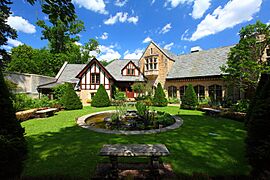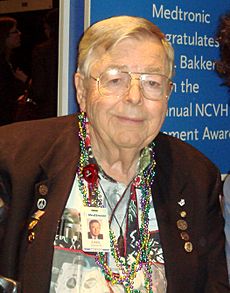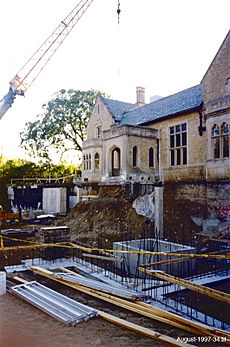The Bakken facts for kids

A view of The Bakken Museum from the medicinal garden
|
|
| Established | 1975–1976 |
|---|---|
| Location | 3537 Zenith Avenue South, Minneapolis, Minnesota, United States |
| Type | Science museum |
The Bakken Museum is a cool science museum located in Minneapolis, Minnesota, in the United States. It was started in 1975 by Earl Bakken. He was also one of the people who created a company called Medtronic.
This museum is full of fun, hands-on exhibits. You can learn about science, technology, and even how people think and create. One of the most famous parts of the museum is a big exhibit all about the classic book Frankenstein by Mary Shelley.
Contents
Exploring Science and History
The Bakken Museum has a huge collection of old books and scientific tools. They have about 11,000 books and 2,000 instruments. Many of these focus on how electricity affects living things and how it was used in medicine long ago.
Some of the important books are by famous scientists like Benjamin Franklin. The museum also has old science magazines. There's a special exhibit about Frankenstein. It shows how electricity and medicine were connected in Mary Shelley's story. This story, and a movie made in 1931, actually inspired Earl Bakken. He later invented the pacemaker and started Medtronic.
Awesome Museum Exhibits
The museum has many exciting exhibits you can explore:
- Spark is the newest exhibit. It helps you understand how people come up with new ideas and inventions.
- Frankenstein’s Laboratory is a special show. It features Frankenstein’s monster in a fun way.
- Deep Roots: Plants as Medicine teaches you about how plants have been used for health for a long time.
- Ben Franklin’s Electricity Party lets you try out cool electric tricks. These are like the ones Ben Franklin did at parties in the 1700s.
- Mary and Her Monster lets you see Mary Shelley’s magic bookcase. It's filled with items and books from the museum's collection. You can solve a puzzle about Frankenstein's story. You can also meet a "living portrait" of Mary. She tells you about the things that inspired her.
- The Florence Bakken Medicinal Garden is a beautiful garden outside the museum. It has plants that were used for medicine. There's also a statue of Hermes, a messenger god from ancient times.
A newspaper reporter once said the museum "seems like a step back in time." They meant it felt like a place where skilled artists made things that would last forever.
The Museum's Story

The Bakken Museum was created by Earl Bakken. He was an inventor who also started the medical technology company Medtronic in 1949. Earl was always fascinated by electricity and inventing new things. When he was a kid, he even made a simple electric device. He used it to keep bullies away at school!
In 1969, Earl Bakken suggested that Dennis Stillings, who worked at Medtronic, start collecting old books and devices. By 1974, this collection became well-known. It grew so much that it needed its own space. It first moved to a floor in a Medtronic office in 1975. Then, in 1976, it began moving to its current home.
The museum used to support a music group called the Bakken Quartet. They played classical music at the museum. Now, the group is called the Bakken Trio. They still perform music in Saint Paul, Minnesota.
The Museum Building
The building where the museum is located was built between 1928 and 1930. It was originally the home of William Goodfellow. He had sold his store to George Dayton, who founded what is now Target Corporation. The house was called "West Winds." It was designed in old English styles, like Tudor and Gothic Revival. It had dark wood, high ceilings, and stained glass windows.
The house originally had fifteen rooms and eleven bathrooms. When Mr. Goodfellow passed away in 1944, he gave the property to the Girl Scouts. Another family lived there from 1953 to 1976. After that, it became The Bakken Museum.
In 1999, the museum got bigger. Its size almost doubled! An underground storage area was built in 1981. This special vault keeps the museum's collection safe. It stays at a steady temperature of 65 degrees Fahrenheit (18 degrees Celsius). It also keeps the air at a certain humidity level.
Images for kids
-
A Frankenstein display
-
Theremin display, which visitors can play








